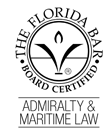The White Island Volcano Eruption – What was Royal Caribbean thinking? A Maritime Attorney’s Perspective.
On December 9th, 2019, the volcano on White Island, New Zealand, erupted while 47 tourists were visiting the Island at the time. Of those, 18 have officially been declared dead, 17 sustained serious burns, and 8 people are missing and presumed dead per publicly available reports. The small Island volcano is privately owned by an Auckland family trust, and as such, only operators with permits were authorized to accompany tourists on guided tours of the Island. White Island Tours was reportedly one of the main authorized tour companies on White Island at the time. The only way to and from the Island is via small inflatable dinghies with tour costs ranging from $229 per adult by boat, to $730 a passenger by helicopter. Tourists on the Island at the time were from Germany, Australia, the UK, China, Malaysia and New Zealand – and 9 people from the United States. New reports indicate that an estimated 38 guests and crew from of the mega cruise ship, Royal Caribbean’s Ovation of the Seas, were on the Island at the time of the disaster. Last week a New Zealand police Commissioner announced they had launched a criminal investigation into the disaster.
This disaster raises serious question why tourists and passengers were allowed, and even encouraged (through brochures and advertising, etc.), to visit this active volcano under existing circumstances. To answer this question, below find historical facts and recommendations from recognized experts (both before and after the December 9th, 2019 eruption).
In a recent article, Monash University professor, Ray Cas, reported Whakaari-White Island is too risky for tourists. “White Island has been a disaster waiting to happen for many years. Having visited it twice, I have always felt that it was too dangerous to allow the daily tour groups that visit the uninhabited Island volcano by boat and helicopter… In a big volcanic incident, it would be impossible to get people off quickly,” says Professor Cas.
TIMELINE
Miami’s Brais Law Firm constructed the below timeline of relevant events:
1885: Major eruption – 12 people killed
2000: White Island in various states of eruptions
2012: Small eruption occurred
2013: Moderate eruption occurred (expert: sufficient to kill visitors)
2016: Major eruption occurred (research Institute GNS Science Duty Volcanologist Geoff Kilgour stated that the initial eruption on Monday lasted a few minutes and was similar to a 2016 eruption when a similar size plume was produced).
11/18/19: (Only 20 days before the Dec. 9th eruption!)
GeoNet[i] Duty Volcanologist Michael Rosenberg issues “Volcanic Alert Bulletin”:
The Volcanic Alert Level is raised to Level 2 (highest level before an eruption).
The Aviation Color Code is increased to Yellow.
Volcanic unrest continues at … White Island and some monitored parameters show further increases in activity. Hazards on the Island are now greater than during the past few weeks … increase in the amount of SO2 gas output … suggests a possible increase in gas passing through the volcano from depth. In the past few weeks, the level of volcanic tremor has also increased from weak to moderate strength … geysering-type activity has been observed at the edge of the lake around the active vents on the west side of the crater floor. The patterns of signals are similar to those through the 2011—2016 period and suggest … may be entering a period where eruptive activity is more likely than normal … These eruptions can occur with little or no warning.
(See also, GeoNet full report below which contains multiple mitigating factors including … “Volcanic tremor can occur for many reasons … [t]he number or locations of earthquakes beneath or near the Island have not changed … Other recent measurements made on the Island … show no significant changes. Changes in volcano monitoring parameters like these are common and can be explained by a range of processes occurring inside the volcano and near the surface. Uncertainty about the exact meaning of these changes often arises from the range of possible processes. Overall, the monitored parameters are just above the expected range for minor volcanic unrest and associated hazards”.
11/24/19: (Only 14 days before the Dec. 9th eruption!) GeoNet reports magnitude 5.9 earthquake occurred beneath eastern Bay of Plenty (note: White Island is also located in the Bay of Plenty).
11/25/19: (Only 13 days before the Dec. 9th eruption!)
GeoNet[ii] Duty Volcanologist Agnes Mazot issues “Volcanic Alert Bulletin”:
Moderate volcanic unrest continues at Whakaari/White Island … Gas emissions continue to be high to moderate in the last week, since Monday 18 November, and volcanic tremor remains at moderate levels. There have been few earthquakes near the Island…gas-driven fountaining activity continues…regularly throwing mud a few meters into the air…eruptive activity is more likely than normal…eruptions can occur with little or no warning. (see GeoNet full report below).
(See also, GeoNet full report below which also contains multiple mitigating factors including … “There has been no change in activity at the volcano after the deep magnitude 5.9 earthquake, that occurred beneath eastern Bay of Plenty on Sunday 11/24 … there have been few earthquakes near the Island … The crater lake level has not changed for the last week, this fountaining is regularly throwing mud a few meters into the air at the vent but at current levels … does not pose a hazard to visitors. Overall, the monitored parameters continue to be in the expected range for moderate volcanic unrest and associated hazards. The monitoring observations are similar to those seen in the more active 2011—2016 period …”).
12/03/19: (Only 6 days before the Dec. 9th eruption!)
GeoNet[iii] Duty Volcanologist Brad Scott issues “Volcanic Alert Bulletin”:
Moderate volcanic unrest continues … substantial gas, steam and mud bursts observed … parameters remain elevated and the Volcanic Alert Level stays at Level 2. Explosive gas and steam-driven mud jetting continues … present since late September, although it is occurring more frequently now. Volcanic gas emission and seismic activity continue to remain elevated … volcanic tremor also remains at moderate levels in the last week … increased gas-steam jetting and fountaining … this fountaining is regularly throwing mud and debris 20-30 meters into the air above the vent … [t]he monitoring observations bear some similarities with those seen during the 2011-2016 period when Whakaari/White Island was more active and stronger volcanic activity occurred. Observations and data to date suggest that the volcano may be entering a period where eruptive activity is more likely than normal. (see GeoNet full report below).
(See also, GeoNet full report below which also contains multiple mitigating factors including … No volcanic ash is being produced…[t]he water level of the crater lake has not changed for the last week … [t]he level of activity is variable and remains within the range expected for moderate volcanic unrest. While the activity is contained to the far side of the lake, the current level of activity does not pose a direct hazard to visitors … [o]verall, the monitored parameters continue to be in the expected range for moderate volcanic unrest and associated hazards exist.)
12/09/19: Only six (6) days after the last “Volcanic Alert Bulletin” White Island volcano erupts killing 18 people / injuring 17 others.
While the victims of the disaster may have various rights under local New Zealand laws, passengers onboard all Royal Caribbean Cruises Ltd., vessels (and other major cruise lines) require all passengers to sign a long and detailed ticket contract which, buried in the fine print, contains a “Forum Selection” clause. By signing, the passenger agrees in contract to bring any/all claims against the company in Miami Federal court, regardless of the location of the accident, injury or death worldwide, and regardless of the citizenship or nationality of the passenger.
There are also very strict notice and filing requirements buried in the ticket contract requiring the passenger to provide written notice to the designated Cruise Line representative within six (6) months of the subject incident and to bring suit within one (1) year of the occurrence of the injury or death. Failure to comply with these requirements leaves open the likely scenario the Cruise line will argue untimely notice and/or filing suit beyond the one-year anniversary renders any/all claim(s) against the Cruise Line invalid.
It was reported that Royal Caribbean guests cruising onboard the Ovation of the Seas who participated in the ill-fated White Island Volcano tour were required to sign a waiver and release of liability by the local tour operator before being permitted to participate in the White Island tour in New Zealand.
Brais Law Firm in Miami is attempting to obtain a copy of the release signed by Royal Caribbean passengers who participated in this tour for further review and legal analysis.
Although Florida law recognizes the right of tour operators to utilize waivers and releases to reduce or eliminate their liability in negligence cases, any claims by cruise passengers or their estates flowing out of this tragedy will be governed by Maritime Law. As such, passengers should not automatically assume that they are bound by the terms and conditions of the release they signed. This is because, in order to be legally valid, any such release and waiver must be clear and unambiguous so that each passenger must be in a position to make a ‘knowing and intelligent’ waiver of their rights. Additionally, while a properly worded release and waiver might (and might not) afford protections to the shoreside excursion company, Cruise Lines are precluded as a matter of law from exculpating themselves from negligence. Therefore, in addition to the excursion company, Royal Caribbean may well be liable to these families:
- If Royal Caribbean failed to sufficiently vet the excursion company, either initially or afterwards on an ongoing basis;
- If Royal Caribbean and the excursion company were joint ventures;
- If the excursion company was an apparent or actual agent of Royal Caribbean; and/or
- Even if the excursion company is deemed an independent contractor, a defense raised by cruise lines in all these cases, Royal Caribbean may well still be liable:
- If the Cruise Line contracted directly with the cruise passengers to provide the shoreside services, and hired the excursion company to fulfill the promised services; and/or
- If the activity, sight seeing on an active volcano, is deemed inherently dangerous.
Royal Caribbean will likely claim it could not have prevented the incident as the eruption was an “unforeseeable ‘Act of God’”. However, even if, for example, a hurricane or a volcanic eruption is considered an “Act of God”, it’s not the hurricane or volcano at issue – it’s what steps a reasonable person or company should have taken after it became aware, or should have become aware, in this case that an active volcano was potentially on the verge of erupting.
The Firm extends its deepest condolences to all those affect by this tragic event. If you, or a loved one were injured or killed in a cruise line or cruise line excursion related accident worldwide, it is important to have your case reviewed by an attorney specializing in the field of Maritime Law. Keith S. Brais is and has been since 1996 a Board-Certified Maritime lawyer with The Florida Bar.
Scroll down to view New Zealand Volcanic Alert System

New Zealand Volcanic Alert Level System
[i] GNS Science is a research institute operating as a limited liability company owned by the New Zealand government, with an independent Board of Directors monitoring geological hazards for the New Zealand Earthquake Commission has a proud tradition of scientific excellence and internationally recognized research. Leading the way are our principal scientists who have substantial and enduring reputations in their fields. They demonstrate high productivity and outstanding achievement in science innovation and original thinking. They are recognized by their peers and by non-research entities as pre-eminent. Our principal scientists attract valuable collaborations and business opportunities and represent New Zealand with distinction on the international stage. The Earthquake Commission is a New Zealand Crown entity investing in natural disaster research, education and providing insurance to residential property owners.
[ii] See above
[iii] See above












